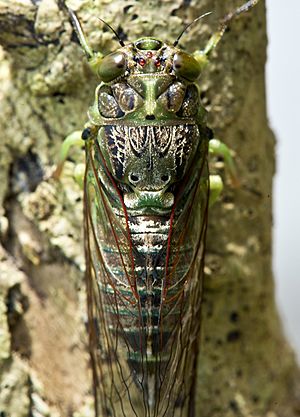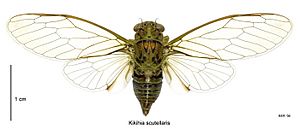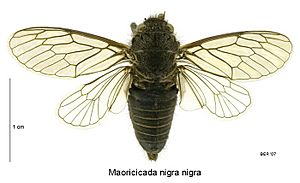List of cicadas of New Zealand facts for kids
Cicadas are amazing insects found all over the world, and New Zealand has its own special kinds! These creatures are famous for the loud buzzing or clicking sounds they make, especially on warm, sunny days. In New Zealand, there are many different types of cicadas, and scientists are still learning about all of them. This article will tell you about some of the cool cicadas that call New Zealand home.
Contents
What are Cicadas?
Cicadas are insects with clear wings and strong bodies. They spend most of their lives underground as nymphs, sometimes for many years! When they are ready, they dig their way out of the soil, climb onto plants, and shed their skin to become adult cicadas.
Adult cicadas live for only a few weeks. During this time, their main job is to find a mate and lay eggs. Male cicadas are the ones that make all the noise. They have special organs called tymbals on their bodies that vibrate super fast to create their loud songs. Each type of cicada has its own unique song, which helps them find others of their kind.
New Zealand has many unique cicada species. Scientists are still studying them to understand all the different types and how they are related.
Types of New Zealand Cicadas
New Zealand is home to several groups, or genera, of cicadas. Each group has different species with their own special looks and songs. Here are some of the main groups you might find:
Amphipsalta
This group includes some of New Zealand's most common cicadas. You've probably heard their songs on a warm summer day!
- Chorus Cicada (Amphipsalta zelandica): This is one of the most well-known cicadas in New Zealand. It makes a loud, steady buzzing sound that can be heard from far away.
- Clapping Cicada (Amphipsalta cingulata): This cicada gets its name from the clapping sound it makes as part of its song.
- Chirping Cicada (Amphipsalta strepitans): As its name suggests, this species is known for its chirping sounds.
Kikihia
The Kikihia group has many different species, often smaller than the Amphipsalta cicadas. They come in various colors, including green, brown, and bronze.
- Lesser Bronze Cicada (Kikihia scutellaris): This cicada is often seen and heard. It has a distinctive bronze color.
- Tussock Cicada (Kikihia angusta): This species is often found in tussock grasslands.
- Clock Cicada (Kikihia horologium): Named for its ticking-like song, this cicada has a unique sound.
- Snoring Cicadas (Kikihia cutora): There are different types of snoring cicadas, known for their low, rumbling sounds.
Maoricicada
These cicadas are often found in cooler, higher places, like mountains and alpine areas. Many of them have dark colors, helping them blend in with rocks and scree.
- High Alpine Cicada (Maoricicada alticola): As its name suggests, this cicada lives in high mountain areas.
- Screaming Cicada (Maoricicada cassiope): This species is known for its very loud and high-pitched song.
- Yodelling Cicada (Maoricicada clamitans): This cicada's song sounds a bit like yodelling.
- Scree Cicadas (Maoricicada mangu): Several types of these cicadas live in rocky, scree-covered areas.
Notopsalta
This group has fewer species, but they are still an important part of New Zealand's cicada family.
- Clay Bank Cicada (Notopsalta sericea): This cicada is often found near clay banks.
Rhodopsalta
These cicadas are sometimes called "Redtail Cicadas" because of their reddish markings.
- Blood Redtail Cicada (Rhodopsalta cruentata): This cicada has striking red colors.
- Sand Dune Redtail Cicada (Rhodopsalta leptomera): This species is often found in sandy dune areas.





